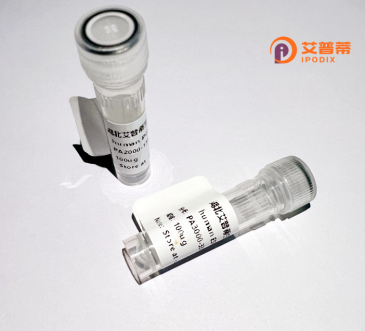
| 纯度 | >90%SDS-PAGE. |
| 种属 | Human |
| 靶点 | TAF4 |
| Uniprot No | O00268 |
| 内毒素 | < 0.01EU/μg |
| 表达宿主 | E.coli |
| 表达区间 | 1-335 aa |
| 活性数据 | MATFVSELEAAKKNLSEALGDNVKQYWANLKLWFKQKISKEEFDLEAHRLLTQDNVHSHNDFLLAILTRCQILVSTPDGAGSLPWPGGSAAKPGKPKGKKKLSSVRQKFDHRFQPQNPLSGAQQFVAKDPQDDDDLKLCSHTMMLPTRGQLEGRMIVTAYEHGLDNVTEEAVSAVVYAVENHLKDILTSVVSRRKAYRLRDGHFKYAFGSNVTPQPYLKNSVVAYNNLIESPPAFTAPCAGQNPASHPPPDDAEQQAALLLACSGDTLPASLPPVNMYDLFEALQVHREVIPTHTVYALNIERIITKLWHPNHEELQQDKVHRQRLAAKEGLLLC |
| 分子量 | 63.8kDa |
| 蛋白标签 | GST-tag at N-terminal |
| 缓冲液 | PBS, pH7.4, containing 0.01% SKL, 1mM DTT, 5% Trehalose and Proclin300. |
| 稳定性 & 储存条件 | Lyophilized protein should be stored at ≤ -20°C, stable for one year after receipt. Reconstituted protein solution can be stored at 2-8°C for 2-7 days. Aliquots of reconstituted samples are stable at ≤ -20°C for 3 months. |
| 复溶 | Always centrifuge tubes before opening.Do not mix by vortex or pipetting. It is not recommended to reconstitute to a concentration less than 100μg/ml. Dissolve the lyophilized protein in distilled water. Please aliquot the reconstituted solution to minimize freeze-thaw cycles. |
以下是关于重组人TAF4蛋白的3篇参考文献及其简要概括:
---
1. **文献名称**: *Structural Insights into the Role of TAF4 in Human TFIID Assembly*
**作者**: Liu X. et al.
**摘要**: 通过冷冻电镜解析了重组人TAF4蛋白在TFIID复合体中的结构,揭示了TAF4如何通过与TAF12等亚基的相互作用稳定TFIID的核架构,并调控RNA聚合酶II的转录起始。
---
2. **文献名称**: *TAF4 Cooperates with Hedgehog Signaling to Reprogram Cancer Cell Metabolism*
**作者**: Gupta S. & Wang Z.
**摘要**: 研究利用重组TAF4蛋白探究其在癌症中的功能,发现TAF4与Hedgehog通路协同作用,通过调控代谢相关基因(如GLUT1)促进肿瘤细胞的糖酵解和增殖。
---
3. **文献名称**: *Recombinant TAF4 Expression and Interaction with Nuclear Hormone Receptors*
**作者**: Martinez E. et al.
**摘要**: 报道了重组人TAF4蛋白的高效表达及纯化方法,并通过体外结合实验证明TAF4直接与核激素受体(如维生素D受体)相互作用,介导配体依赖的转录激活。
---
如需具体文章,建议通过PubMed或Sci-Hub输入标题及作者检索原文。
**Background of Recombinant Human TAF4 Protein**
TAF4 (TATA-box binding protein-associated factor 4) is a critical subunit of the transcription factor IID (TFIID) complex, a multiprotein assembly essential for initiating RNA polymerase II-mediated transcription. TFIID binds core promoter elements, including the TATA box, to recruit transcriptional machinery and regulate gene expression. TAF4 acts as a structural scaffold, stabilizing interactions between other TAF subunits (e.g., TAF12) and facilitating TFIID assembly. It contains conserved domains, such as the histone fold domain (HFD), which mediates heterodimer formation with TAF12. a key step in TFIID’s chromatin-binding and transcriptional activation functions.
Studies highlight TAF4’s role in embryogenesis, cell differentiation, and tissue-specific gene regulation. Dysregulation of TAF4 is linked to developmental disorders, cancer, and neurodegenerative diseases, underscoring its importance in maintaining cellular homeostasis. Recombinant human TAF4 protein, produced via expression systems like *E. coli* or mammalian cells, enables biochemical studies, including TFIID reconstitution, promoter-binding assays, and interaction mapping. It also serves as a tool for screening therapeutic compounds targeting transcriptional dysregulation. By elucidating TAF4’s molecular mechanisms, researchers aim to uncover novel strategies for modulating aberrant gene expression in disease contexts.
×